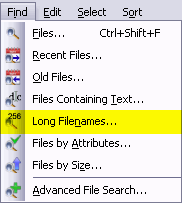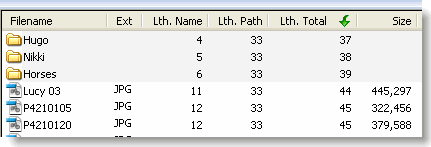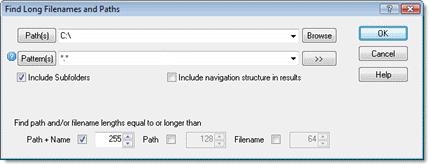The BEST File Manager for Windows
Works with and greatly enhances:
Windows 11, 10
Windows 8, 7, Vista, XP
Servers 2003 and later
Starting at just $50 for home use and $69 for a business license (and a business two-pack for just $99!)
What's New / What's Up
Version 4: the future
Major new tools, significant upgrades to current components and faster folder listings.
- Find and rename problem files: bad paths, illegal characters, Linux & iOS (Mac) characters.
- Check files and folders for compliance with different file systems e.g., NTFS, Fat-16, Fat-32, eFat, CDs, iOS, Linux and custom.
Know if the files are right before you copy. - Delete files no matter their length or how they are named.
- Powerful renaming with RegEx e.g. change 'Romeo Smith' into 'Smith, Romeo' and much more.
- Lightening fast directory listing no matter how large the folder.
- Detailed reports for copy errors.
- Variable text size for views and dialogs.
- and many more improvements and fixes..
See the V4 preview here.
Update May 2017
A May 2017 Microsft security update for Windows 10 conflicted with a major routine in FileBoss resulting in FileBoss not starting on some Windows 10 systems.
Versions V3.101 and later, fix the problem. You can read more about this at the page
Windows Creators Conflict.
Finding Long Filenames
For and introduction to what constitutes a long filename and why they should be avoided see: Long Filenames - How long is too long on our blog.
Find Files with Long Filenames
Open the controlling dialog
-
 Select
Find | Long Filenames...
or (Alt+I,N) from the main menu to open the dialog where you can specify exactly which files you want to find.
Select
Find | Long Filenames...
or (Alt+I,N) from the main menu to open the dialog where you can specify exactly which files you want to find. - If one or more folders are selected they will be automatically entered into the Paths filed of the dialog when it opens
- FileBoss remembers what has been searched in the past even when it has been closed and then started again so you can always select a previous entry using the drop down list.
Specify what you want to find
- Select the drives or paths you want to check. Multiple paths are separated with the semi-colon (;), comma (,) or bar character (|). You can even specify folders to exclude by preceding the name with a minus sign. For complete details right-click the field in the program.
- Then select which length you want to find and enter the number of character. Normally it the Path + Name, i.e. the total length, that you will want to find.
- Click OK to search and create a Virtual Folder of all matching files
In the above example FileBoss will find all files C drive and on a network beginning with the folder \\CorpNet\c\Backup\Design except for any folder named Windows and all of its subfolders. The search will be for filenames with a total length of 255 characters or longer.
More about entering multiple paths and patterns
![]()

Both the paths and file patterns fields can accept either simple entries, e.g.
C\Data\My Data and *.bmp or very complex strings that specify not only what to include but also what to exclude from a, most typically, search.
For instance both can specify multiple objects such as
C\Data\My Data ; D:\Backup\MyData
and
*.bmp ; *.gif ; *.png ; *.jpeg ; *.jpg
For a complete description of these fields either right-click the mouse over the fields for context help from within FileBoss or see Advanced Paths & Patterns.
Sorting by Filename Lengths
- Make sure that the column for showing the column for showing the filename length your are interested in is visible (if not see the next section for how to display the column).
- Click on the appropriate column header to sort all entries by the length. Click the column header again to reverse the sort order.

- If you are in Explore View then as you move from folder to folder the files will remain sorted according to chosen time.
Hint: If you are looking at folders that contain lots of files you can and you know the extension or possible extensions of the file(s) you are looking for you can use a File Filter to only display those files.
Or you can even used Advanced Filtering to only show files with Modified times in the range you want.
Displaying the Filename Lengths in the Contents Window
(If the filename lengths are not already displayed in the Contents Window)
- This works the same in both Explore Views and Virtual File Sets.
- Move the mouse over the column headers (the column headers are at the top of the Contents Window and have titles like Filename, Ext and Size.)
- Right-click the to display a list of columns that can be displayed
- Check the boxes next to items you want displayed.
- Click the Close Menu button.
Hint: You can change the order of the columns by clicking a header with the left mouse button and, while holding the mouse button down, dragging the column to its new location.
Rename the Files
- Note that when renaming files to make the total path length shorter it is often convenient to rename one of the folder names. Just make sure that renaming the folder won't break any of the other programs on you system.
- Select the files you want to rename.
- If each of the files must be manually renamed press Alt+Ctrl+R to rename each file by hand. (Note that the rename dialog conveniently separates the root name and the extension so that you won't accidentally change the extension of a file.)
- or if the files can be renamed in groups, press Ctrl+R and use one of FileBoss's powerful renaming tools.
Click here for more about FileBoss's powerful renaming facilities.


 What do you need to do today?
What do you need to do today?